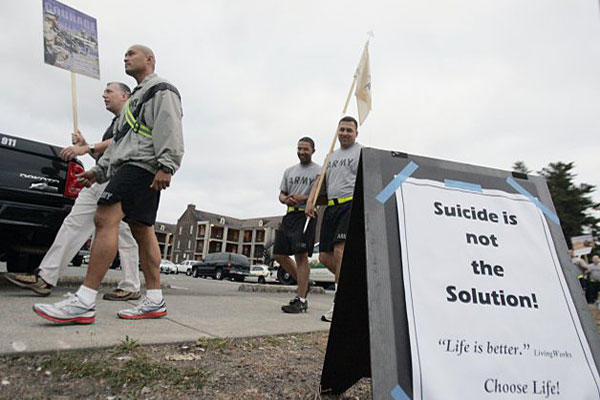FORT CAMPBELL, Ky. -- As the military suicide rate climbed in July to yet another one-month record high, one Army post may be on the verge of witnessing a rate decrease.
Fort Campbell, which in 2009 led the Army in suicides, has spent the last several years taking what the Army sees as drastic steps toward suicide prevention education. In 2008, it became the first post in the Army to hire a suicide prevention manager.
In 2010, it added to its prevention arsenal and placed a behavioral health official with five of the 101st Airborne’s brigades. And in 2012, it began the rollout of division-wide 13-person psychiatric “resiliency teams,” embedded so far with 101st’s 1st and 4th brigades -- another Army first.
In still another program, the post has assigned a pharmacist to monitor the post’s soldiers who have been prescribed four or more medications, including one psychotropic, to make sure they both still need the medications and are taking them properly. As of mid-September, 303 soldiers were being monitored in that program.
Coupled with the Army-wide “standdown” suicide prevention training days scheduled for this week, yet another program piloted at Fort Campbell in 2009, the steps toward prevention seem to be doing something that has eluded other Army programs -- working.
Poll: Is Military Suicide Preventable?
“Anything greater than zero is a rise that we’d rather not see,” said Joseph Varney, Fort Campbell’s suicide prevention program manager. “But we actually know that our efforts are paying off, and we know that because we review the military police reports and hospital reports every day and read about the suicides that didn’t happen -- because someone intervened.”
As of Sept. 24, 140 soldiers Army-wide had committed suicide in 2012, putting this year on track to be the third record suicide year in a row, and the seventh year out of the last eight that the Army has seen a steady increase in the suicide rate, Varney said. Twelve of the 140 were stationed at Fort Campbell, he said.
Thirty-eight of this year’s 140 suspected, or confirmed, suicides occurred in July alone, a record high for any single month. No Fort Campbell soldiers committed suicide in July.
Between 2009 and 2011, Fort Campbell bucked the Army trend and saw its suicide rate steadily decrease from 21 in 2009 to six last year. And even though the Fort Campbell rate will likely hit a new record high this year along with the rest of the Army, the timing of the Fort Campbell suicides suggest that the prevention training is starting to sink in.
Military suicides are historically linked to the 90 days before a deployment and the 90 days afterward, Varney said. But with several Fort Campbell brigades either about to leave for Afghanistan or recently departed over the last three months, the lag in suicides over that predeployment window may be a good sign.
The Army-wide standdown days, advertised as “stand up” days on Campbell, are set to include two days of intervention and resiliency training conducted by health care officials and Army chaplains. They are aimed at teaching soldiers to not only recognize the signs of suicide in themselves and seek help, but even more importantly, to watch for signs in their friends and reach out on their behalf.
“A keen observer can tell when someone is under [suicidal] stress,” Varney said. “We have to teach people to know the signs and tell someone when they see someone else exhibiting those signs. … People don’t want to get into each other’s business. But that’s not the solution.”
The programs across post look to focus on prevention as well, with “the entire community working together,” said Laura Boyd, a spokesman for Campbell’s Blanchfield Army Community Hospital. They aim to teach every medical provider to spot the signs of suicide, and every leader and worker to intervene, regardless of whether they are in the mental health field.
Still, there is one group on the outside of most of the Army and Fort Campbell’s suicide prevention training efforts: military families.
"Our soldiers are the strength of the nation, and our families are the strength of our soldiers,” Maj. Gen. James McConville, commander of Campbell’s 101st Airborne Division, said early this month. “It is important that we do all that we can to ensure that our families are taken care of and are as resilient as possible to withstand the demands of Army life."
And yet connecting families with any programs, including almost 600 on Fort Campbell, is a huge challenge, officials acknowledge.
Part of the problem, said Varney, is simply spreading the word that help exists. While soldiers can be force-fed training and intervention as part of their duty day, spouses live outside the chain of command. And while spouses are invited to attend programs, such as the Fort Campbell standdown events and a new “master resiliency” course, they cannot be ordered to do anything.
“We spend every day asking ourselves the question of how we can get the word out about all of these programs,” Varney said.
The military tracks suicides among civilian military spouses when possible. Army numbers show the rate climbed from 11 Army family suicides in 2009 to 14 in 2010 and down to 13 in 2011, Varney said.
But the anecdotal evidence indicates the rate is much higher. Tracking the number can be almost impossible because spouses and family members are generally civilians and may not live on or around a military base. Their death may not be reported to the Army as a suicide.
“Essentially, we know what leads people to suicide -- it’s stress,” Varney said. “What we don’t know is who has the ability to relieve that stress.”

























